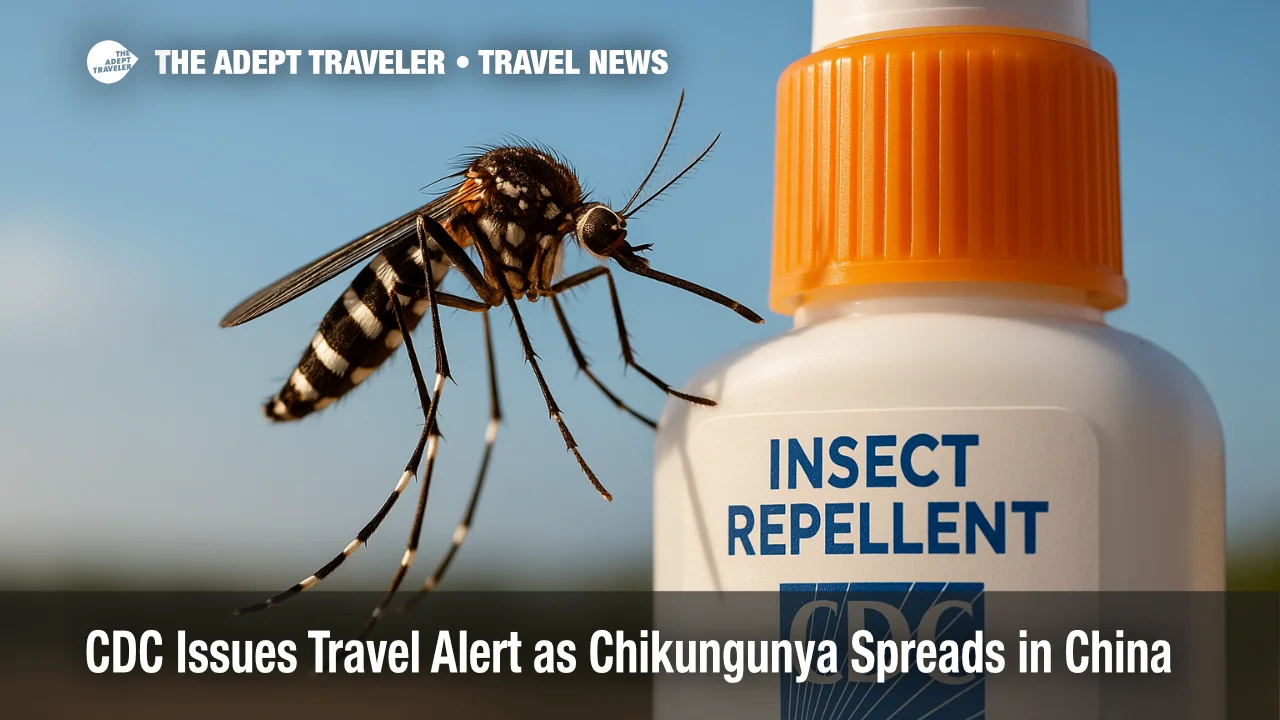CDC Issues Travel Alert as Chikungunya Spreads in China

U.S. health officials have elevated their warning for travelers bound for southern China after a fast growing chikungunya outbreak in Guangdong Province surpassed 5,000 cases. A Level 2 Travel Health Notice from the Centers for Disease Control and Prevention (CDC) urges travelers to practice enhanced precautions, seek vaccination when appropriate, and expect intensified mosquito control measures in affected cities such as Foshan. The move comes just two days after Reuters first reported the agency was weighing the alert amid an exponential rise in infections. With China's peak summer travel season under way, the guidance could influence flight bookings and itineraries throughout East Asia.
Key Points
- Why it matters: Guangdong now accounts for the largest chikungunya outbreak ever recorded in China.
- Travel impact: CDC's Level 2 notice recommends mosquito avoidance and, for some travelers, vaccination before departure.
- What's next: Provincial health teams are deploying larva eating fish and street by street cleanup drives; further CDC escalation remains possible.
- Surge passes 5,100 confirmed cases, most in Foshan.
- Two U.S.-licensed vaccines-IXCHIQ and VIMKUNYA-are available for at-risk travelers.
Snapshot
The CDC posted its Level 2 advisory on August 1, 2025, less than a week after Guangdong's health commission reported 4,824 infections. By August 2, Foshan alone had logged 5.155 laboratory-confirmed cases, prompting officials to raise their public health response to Level III, one step below a full emergency. While most illnesses are mild, chikungunya's hallmark joint pain can linger for months, hindering mobility and quality of life. No specific antiviral treatment exists, so prevention centers on vaccination for eligible travelers and rigorous avoidance of Aedes mosquito bites. The CDC emphasizes daytime repellant use, loose-fitting long sleeves, screened rooms, and air-conditioned lodging.
Background
First isolated in Tanzania in 1952, the chikungunya virus has migrated with its Aedes mosquito hosts to more than 110 countries. Guangdong's humid subtropical climate already supports dengue transmission; warming temperatures and urbanization have expanded the range of Aedes albopictus, the "Asian tiger" mosquito now driving China's outbreak. Infected travelers can seed new clusters: the viremic phase during the first week of illness is sufficient to infect local mosquitoes at their next blood meal. Previous Asian outbreaks-such as the 2005 wave on Réunion Island and the 2017 surge in Pakistan-show how rapidly case counts can balloon once local vectors amplify the virus.
Latest Developments
CDC details new precautions for U.S. travelers
The August 1 notice advises travelers heading to Guangdong, Hong Kong, or nearby transit hubs to consult a health provider at least four weeks before departure. The agency recommends either IXCHIQ, a single dose live attenuated vaccine, or VIMKUNYA, a two dose virus like particle shot, for adults at higher risk. Side effects are generally mild, although immunocompromised travelers should discuss options carefully. The CDC also updated its China country page with insect-bite-avoidance tips, stressing daytime protection because Aedes mosquitoes feed most aggressively in early morning and late afternoon.
Guangdong scales up vector control and surveillance
Local authorities released 5 ,00 larva-eating fish into stagnant ponds, launched neighborhood cleanup drives, and increased fines for uncovered water containers. Health workers in Foshan and Guangzhou are sampling mosquitoes daily to monitor viral load and insecticide resistance. Officials report that more than 85 percent of recent cases experienced fever and debilitating polyarthralgia, but hospitalizations remain low. While the outbreak is still classified as "relatively major" under China's four-tier system, modeling by Guangdong Center for Disease Control suggests a potential northward shift of high-risk zones if temperatures remain above 86 °F through September.
Analysis
China's chikungunya surge illustrates how climate change, global mobility, and urban sprawl converge to resurrect once-tropical diseases in new latitudes. Daytime biting Aedes mosquitoes thrive in container habitats flowerpots, roof gutters, even discarded bottle caps, common across Guangdong's densely populated Pearl River Delta. Unlike malaria-carrying Anopheles mosquitoes, which are active at night and are declining thanks to bed-net campaigns, Aedes species are far harder to avoid during daylight commerce and commuting.
For airlines and tour operators, the CDC's Level 2 notice poses logistical questions. Travelers may rebook or cancel to avoid perceived health risks, and carriers must brief crews on mosquito control during ground time. Cruise lines sailing from Hong Kong or Shenzhen could also face itinerary reviews. At the same time, vaccination offers a new revenue stream for travel clinics, and the advisory stops short of recommending that Americans defer travel. That balance reflects a broader shift in global health messaging: empowering travelers with tools-vaccines, repellents, and real-time alerts-rather than blanketing destinations with bans that hurt local economies. Long term, success will hinge on whether Guangdong's aggressive vector-control experiment can break transmission before the virus gains a foothold in northern provinces.
Final Thoughts
For U.S. travelers mapping late summer or Golden Week trips, the Guangdong chikungunya outbreak is a timely reminder that itinerary planning must include health readiness. Schedule a pre-travel consult, weigh vaccination, and pack EPA registered repellant alongside your passport. Staying vigilant now will help keep your journey-and those of fellow travelers-free from the joint-crippling pain that defines every chikungunya outbreak.
